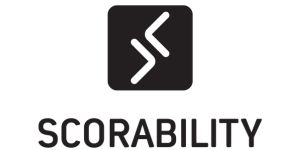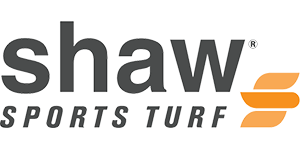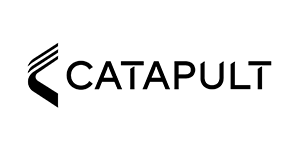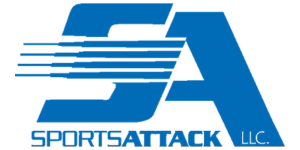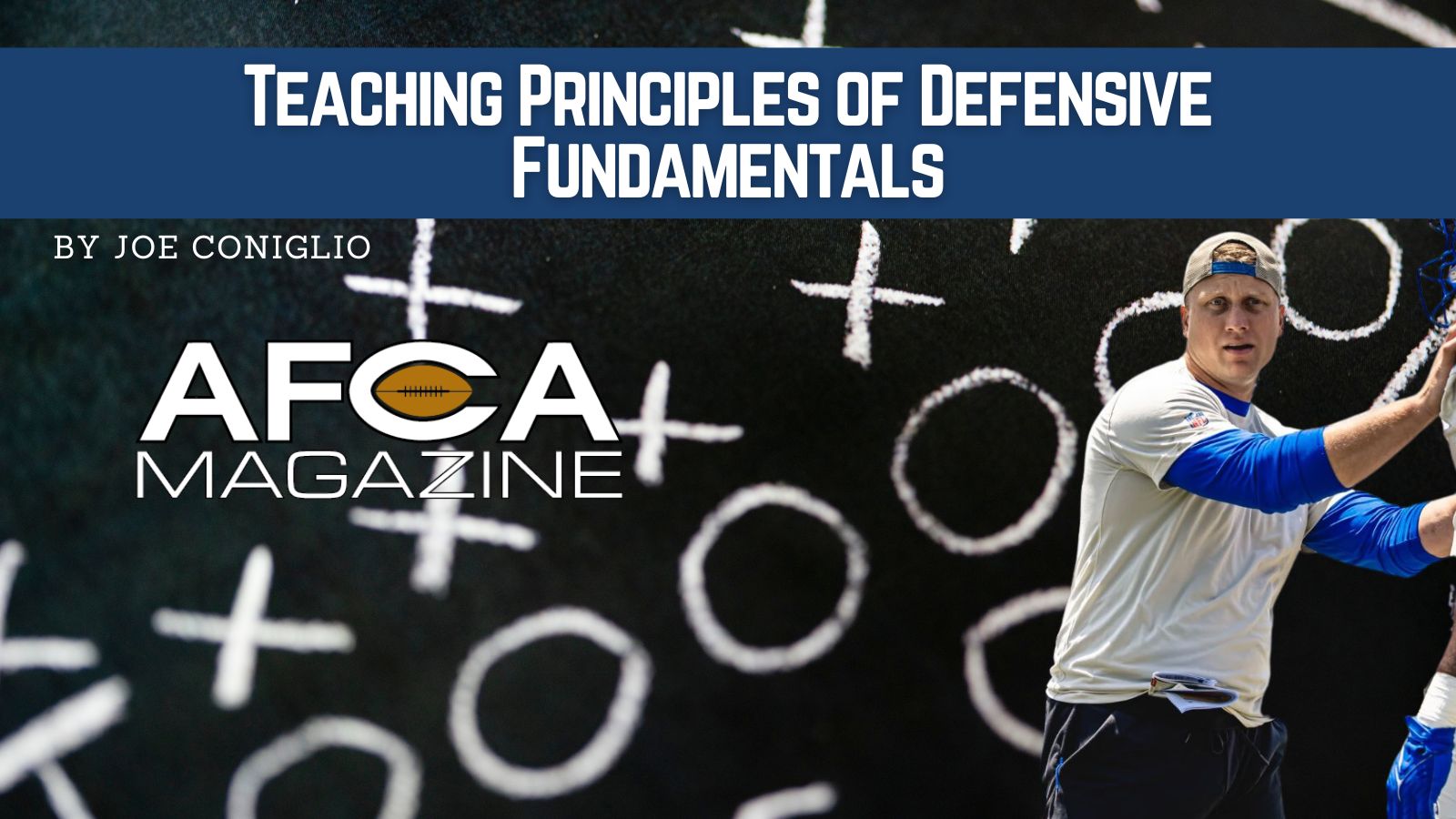
Teaching Principles of Defensive Fundamentals
September 15, 2023
Excelling in defensive football requires two important fundamentals and their execution: 1) the ability to engage and defeat blockers and 2) the ability to successfully tackle. These skills are achieved through detailed communication, thorough application, and are essential to building a competitive defense. For players to meet their coaches’ expectations, they must have precision in their knowledge and understanding of these expectations. We teach with a defined process and detailed coaching, which provides our players with the confidence to attack offenses and play winning defense.
How we teach is essential to our players and their development. If a concept is important to our staff, we need to effectively communicate it so that our players will have the same mindset. Developing football skills and fundamentals starts with an in-depth approach with the goal of improving our players’ ability to learn and apply instruction. Our communication fundamentals are to be: 1) clear, 2) clean, 3) concise, and 4) direct. By consistently practicing these fundamentals, coaches will enable players to reach their full potential.
To be clear is to communicate with no gray area. We coach to improve a skill until it is executed correctly. This involves coaching every aspect of a fundamental and accepting nothing less than excellence. Using clean communication means speaking with confidence and being easily understood. As a coach, speaking with conviction creates trust and believability within a position, unit, and team. We expect our implementation of philosophy, a drill, or a scheme to be something our players are excited about. Being concise breaks our teaching down to the simplest detail. This results in straightforward, repeatable coaching points that assist our players in understanding how to enhance their skills. Lastly, being direct ties our process together as our players can recite information back to us that we have previously taught them. This allows them to speak like a coach while improving their football IQ and on-field process. These communication principles maximize our players ability to take information from the meeting room and apply it on the field. These principles also help coaches implement individual lesson plans which give players daily coaching points and feedback, in a fundamental and organized way.
Our ‘blow delivery’ is also known as our ‘winning edge’ fundamental. This is an integral part of our program. Our staff and players believe it will improve our ability to play any position on defense. To reinforce its importance, we consistently integrate it into meetings and drills. When mastered, it gives our team a winning advantage. ‘Blow delivery’ takes place when we are close enough to shake hands with an opposing player. This act gives us a clear understanding of the space and time needed to create a successful blow to an opponent. As a result, we will be better able to target the breast plate and anticipate inside hand placement. We define the ‘winning edge’ fundamental using five coaching points: 1) hairline below chin, 2) thumbs up, 3) wrist and elbows together, 4) speed to lock, and 5) hands above eyes. Having our players hairline below the chin is a pad-under-pad mentality, with the understanding that the low man wins. Striking with thumbs up helps us violently engage our target. It creates an explosion from our hips to the man, generating a powerful hand strike and uses the heel of the thumb as a battering ram. Putting our wrists and elbows together allows us to ‘win the chest’ with inside hand placement and control our opponent. If our opponent wins inside hand placement, we will use a single-hand replacement technique, helping us regain an advantage. Once we strike, we create a sudden snap which we call ‘speed to lock’. This is our ability to quickly get our elbows locked out and create space between us and an offensive player. Critical to our ‘speed to lock’ is that our hips don’t roll forward, we want to keep our hips back to create maximum space from an offensive player. The only time our hips will roll through is when tackling the opponent. Once ‘speed to lock’ is obtained, we want to ensure our hands are above our eyes for maximum leverage and a body position advantage. This creates a powerful shin angle, which gets us in a power position to create an advantage. These simple and precise coaching points create terminology that is consistent from coaches to players and vice versa when speaking in our football language.
The ‘winning edge’ technique allows us to play the game on our terms giving us the opportunity to control blockers and to attack and disrupt offenses. Once we perfect the execution of the ‘winning edge,’ we must have the ability to get off blocks. The tools we give players include a swipe or a rip that is executed with the inside arm in relationship to the ball. A swipe will be executed tight off the shoulder pad of the offensive player. A rip will be executed up and through the armpit. These disengagement techniques will take place once the ball shows. All block destruction will conclude by clearing the opponent’s hip and bringing our back foot through, creating power and violence. The goal is to ‘rub paint’ off the blocker’s hip to decrease space and eliminate his ability to affect the play once we have disengaged. Defeating a block too early or too late in a play can be disastrous. Disengagement too early will give the opponent the opportunity to re-engage, and disengagement too late can create a lost opportunity. The ability to disengage when the ball shows, gives us the opportunity to make the play and tackle the ball regardless of gap responsibility. This leads us to tackling fundamentals and processes.
Tackling is another skill we emphasize consistently on defense. We are a shoulder leverage tackling team; therefore, we keep our head out of the tackle. We break our tackling down into three segments: 1) approach, 2) fit, and 3) ‘killing the engine’. Our coaches and players have the responsibility of knowing these segments and corresponding fundamentals when communicating.
Our tackling approach is the attacking nature with which we are going to move toward the ball carrier. We have a three-step process that we use to implement this approach: 1) leverage shoulder, 2) eyes on the near hip, and 3) long stride, short stride, and shimmy. These three fundamentals clearly define how we want to attack a ball carrier as a shoulder leverage tackling team. In our approach phase, we must understand if we have defined leverage or undefined leverage. If leverage is defined, we maintain our leverage; if it is undefined, we fit to our help. Putting our eyes on the near hip helps us maintain leverage throughout the approach, which will dictate our body control. Long stride, short stride, and shimmy are buzzwords to get our players into a proper fit position on the ball carrier. Long stride is a “go” and eliminates space mentality. Short stride is a “throttle” mentality that helps maintain leverage and body control. Lastly, shimmy puts us in a position to make a tackle with a near leg, near shoulder relationship to the ball carrier. This allows us to maintain leverage through contact. Understanding exactly when to implement each is critical to being a great tackling team. If you don’t shimmy in time, you risk missing the ball carrier entirely; if you shimmy too early, you give the ball carrier multiple options. These tools help maximize defensive fundamentals and leverage which gives us tools to get the ball carrier on the ground. As a result, we are better able to throttle down and be put in a position to get into a proper fit.
Our tackling fit is when we are connected with a ball carrier. We have a three-step progression that implements how our fit is taught: 1) near leg – near shoulder, 2) cheek to cheek, 3) violent scissors. Once we get to the moment of contact, we want to make sure we are in a near leg – near shoulder position. We consider this the most powerful position in football. It gives us the opportunity to blunt the charge of the ball carrier. Once in this position, we gain a pad-level advantage by putting the cheek of our face on the cheek of the offensive player’s butt. It is imperative we have a good bend in our ankles and knees while in this position. We then spread the net of our arms and scissor the ball carrier’s legs with a physical and aggressive demeanor. A violent scissor is crucial to a great tackling fit. Once we scissor the legs, the next step in the tackling process is to ‘kill the engine’.
The engine is the leg drive of the ball carrier. We do this by 1) putting eyes through thighs, 2) driving for five yards, 3) rolling, or 4) ‘sweeping the ankle’. These tools are vital to taking the ball carrier to the ground. Our cheek-to-cheek fit allows us to slide to the thigh of the offensive player. We then focus our eyes through the thigh of the opponent and drive for five yards taking the ball carrier to the ground. In a situation where we are attacking a ball carrier from a side angle, we scissor and roll using the same tackling process. We do this by rolling to our leverage. For example, with a right shoulder side tackle, we roll to our left. Another tool is when we are pursuing a ball carrier from behind, we can use a tackling technique we call ‘sweep the ankle’. This is accomplished by launching our body and attacking the opponent’s ankle using one arm and an open hand to create maximum length. We turn our bodies 90 degrees in the air to give us torque when attempting to get an opponent on the ground. By executing this technique, we can trip an offensive player to the ground as a last-resort tackling technique.
Having a defined communication approach when teaching defensive fundamentals is important to a player’s retention and application. We constantly include blow delivery and tackling in our meetings and on-field drills, which gives our players knowledge and assists them in skill development. These tools are necessary for our players to have confidence when playing defense. We believe using precise coaching points strengthens individual growth while creating a common language. Consistency with terminology plays a pivotal role in teaching football and gives our staff the ability to assess defensive fundamentals in a concise way.
For more information about the AFCA, visit www.AFCA.com. For more interesting articles, check out The Insider and subscribe to our weekly email.
If you are interested in more in-depth articles and videos, please become an AFCA member. You can find out more information about membership and specific member benefits on the AFCA Membership Overview page. If you are ready to join, please fill out the AFCA Membership Application.
« « Previous PostNext Post » »
Excelling in defensive football requires two important fundamentals and their execution: 1) the ability to engage and defeat blockers and 2) the ability to successfully tackle. These skills are achieved through detailed communication, thorough application, and are essential to building a competitive defense. For players to meet their coaches’ expectations, they must have precision in their knowledge and understanding of these expectations. We teach with a defined process and detailed coaching, which provides our players with the confidence to attack offenses and play winning defense.
How we teach is essential to our players and their development. If a concept is important to our staff, we need to effectively communicate it so that our players will have the same mindset. Developing football skills and fundamentals starts with an in-depth approach with the goal of improving our players’ ability to learn and apply instruction. Our communication fundamentals are to be: 1) clear, 2) clean, 3) concise, and 4) direct. By consistently practicing these fundamentals, coaches will enable players to reach their full potential.
To be clear is to communicate with no gray area. We coach to improve a skill until it is executed correctly. This involves coaching every aspect of a fundamental and accepting nothing less than excellence. Using clean communication means speaking with confidence and being easily understood. As a coach, speaking with conviction creates trust and believability within a position, unit, and team. We expect our implementation of philosophy, a drill, or a scheme to be something our players are excited about. Being concise breaks our teaching down to the simplest detail. This results in straightforward, repeatable coaching points that assist our players in understanding how to enhance their skills. Lastly, being direct ties our process together as our players can recite information back to us that we have previously taught them. This allows them to speak like a coach while improving their football IQ and on-field process. These communication principles maximize our players ability to take information from the meeting room and apply it on the field. These principles also help coaches implement individual lesson plans which give players daily coaching points and feedback, in a fundamental and organized way.
Our ‘blow delivery’ is also known as our ‘winning edge’ fundamental. This is an integral part of our program. Our staff and players believe it will improve our ability to play any position on defense. To reinforce its importance, we consistently integrate it into meetings and drills. When mastered, it gives our team a winning advantage. ‘Blow delivery’ takes place when we are close enough to shake hands with an opposing player. This act gives us a clear understanding of the space and time needed to create a successful blow to an opponent. As a result, we will be better able to target the breast plate and anticipate inside hand placement. We define the ‘winning edge’ fundamental using five coaching points: 1) hairline below chin, 2) thumbs up, 3) wrist and elbows together, 4) speed to lock, and 5) hands above eyes. Having our players hairline below the chin is a pad-under-pad mentality, with the understanding that the low man wins. Striking with thumbs up helps us violently engage our target. It creates an explosion from our hips to the man, generating a powerful hand strike and uses the heel of the thumb as a battering ram. Putting our wrists and elbows together allows us to ‘win the chest’ with inside hand placement and control our opponent. If our opponent wins inside hand placement, we will use a single-hand replacement technique, helping us regain an advantage. Once we strike, we create a sudden snap which we call ‘speed to lock’. This is our ability to quickly get our elbows locked out and create space between us and an offensive player. Critical to our ‘speed to lock’ is that our hips don’t roll forward, we want to keep our hips back to create maximum space from an offensive player. The only time our hips will roll through is when tackling the opponent. Once ‘speed to lock’ is obtained, we want to ensure our hands are above our eyes for maximum leverage and a body position advantage. This creates a powerful shin angle, which gets us in a power position to create an advantage. These simple and precise coaching points create terminology that is consistent from coaches to players and vice versa when speaking in our football language.
The ‘winning edge’ technique allows us to play the game on our terms giving us the opportunity to control blockers and to attack and disrupt offenses. Once we perfect the execution of the ‘winning edge,’ we must have the ability to get off blocks. The tools we give players include a swipe or a rip that is executed with the inside arm in relationship to the ball. A swipe will be executed tight off the shoulder pad of the offensive player. A rip will be executed up and through the armpit. These disengagement techniques will take place once the ball shows. All block destruction will conclude by clearing the opponent’s hip and bringing our back foot through, creating power and violence. The goal is to ‘rub paint’ off the blocker’s hip to decrease space and eliminate his ability to affect the play once we have disengaged. Defeating a block too early or too late in a play can be disastrous. Disengagement too early will give the opponent the opportunity to re-engage, and disengagement too late can create a lost opportunity. The ability to disengage when the ball shows, gives us the opportunity to make the play and tackle the ball regardless of gap responsibility. This leads us to tackling fundamentals and processes.
Tackling is another skill we emphasize consistently on defense. We are a shoulder leverage tackling team; therefore, we keep our head out of the tackle. We break our tackling down into three segments: 1) approach, 2) fit, and 3) ‘killing the engine’. Our coaches and players have the responsibility of knowing these segments and corresponding fundamentals when communicating.
Our tackling approach is the attacking nature with which we are going to move toward the ball carrier. We have a three-step process that we use to implement this approach: 1) leverage shoulder, 2) eyes on the near hip, and 3) long stride, short stride, and shimmy. These three fundamentals clearly define how we want to attack a ball carrier as a shoulder leverage tackling team. In our approach phase, we must understand if we have defined leverage or undefined leverage. If leverage is defined, we maintain our leverage; if it is undefined, we fit to our help. Putting our eyes on the near hip helps us maintain leverage throughout the approach, which will dictate our body control. Long stride, short stride, and shimmy are buzzwords to get our players into a proper fit position on the ball carrier. Long stride is a “go” and eliminates space mentality. Short stride is a “throttle” mentality that helps maintain leverage and body control. Lastly, shimmy puts us in a position to make a tackle with a near leg, near shoulder relationship to the ball carrier. This allows us to maintain leverage through contact. Understanding exactly when to implement each is critical to being a great tackling team. If you don’t shimmy in time, you risk missing the ball carrier entirely; if you shimmy too early, you give the ball carrier multiple options. These tools help maximize defensive fundamentals and leverage which gives us tools to get the ball carrier on the ground. As a result, we are better able to throttle down and be put in a position to get into a proper fit.
Our tackling fit is when we are connected with a ball carrier. We have a three-step progression that implements how our fit is taught: 1) near leg – near shoulder, 2) cheek to cheek, 3) violent scissors. Once we get to the moment of contact, we want to make sure we are in a near leg – near shoulder position. We consider this the most powerful position in football. It gives us the opportunity to blunt the charge of the ball carrier. Once in this position, we gain a pad-level advantage by putting the cheek of our face on the cheek of the offensive player’s butt. It is imperative we have a good bend in our ankles and knees while in this position. We then spread the net of our arms and scissor the ball carrier’s legs with a physical and aggressive demeanor. A violent scissor is crucial to a great tackling fit. Once we scissor the legs, the next step in the tackling process is to ‘kill the engine’.
The engine is the leg drive of the ball carrier. We do this by 1) putting eyes through thighs, 2) driving for five yards, 3) rolling, or 4) ‘sweeping the ankle’. These tools are vital to taking the ball carrier to the ground. Our cheek-to-cheek fit allows us to slide to the thigh of the offensive player. We then focus our eyes through the thigh of the opponent and drive for five yards taking the ball carrier to the ground. In a situation where we are attacking a ball carrier from a side angle, we scissor and roll using the same tackling process. We do this by rolling to our leverage. For example, with a right shoulder side tackle, we roll to our left. Another tool is when we are pursuing a ball carrier from behind, we can use a tackling technique we call ‘sweep the ankle’. This is accomplished by launching our body and attacking the opponent’s ankle using one arm and an open hand to create maximum length. We turn our bodies 90 degrees in the air to give us torque when attempting to get an opponent on the ground. By executing this technique, we can trip an offensive player to the ground as a last-resort tackling technique.
Having a defined communication approach when teaching defensive fundamentals is important to a player’s retention and application. We constantly include blow delivery and tackling in our meetings and on-field drills, which gives our players knowledge and assists them in skill development. These tools are necessary for our players to have confidence when playing defense. We believe using precise coaching points strengthens individual growth while creating a common language. Consistency with terminology plays a pivotal role in teaching football and gives our staff the ability to assess defensive fundamentals in a concise way.
For more information about the AFCA, visit www.AFCA.com. For more interesting articles, check out The Insider and subscribe to our weekly email.
If you are interested in more in-depth articles and videos, please become an AFCA member. You can find out more information about membership and specific member benefits on the AFCA Membership Overview page. If you are ready to join, please fill out the AFCA Membership Application.


